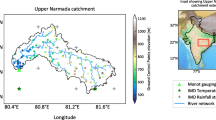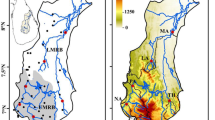Abstract
The aim of this study is to evaluate the performance of hydrological model - Soil & Water Assessment Tool (SWAT) in two distinct catchments, under various Digital Elevation Model (DEM) scenarios of varying resolution (from 30 m to 300 m), sources (SRTM, ASTER and CartoDEM) and resampling methods (nearest neighbour, bilinear interpolation, majority and cubic convolution) available with ArcGIS software package. A comparison was made in between model response of highly elevated Himalayan Upper Teesta catchment and peninsular monsoon dominated Upper Narmada catchment in India. Model performance was assessed & subsequently compared based on statistical measures such as coefficient of determination (R2) and Nash-Sutcliffe Efficiency (NSE), for monthly runoff and sediment yield. The sensitivity of monthly model outputs of runoff, sediment yield, Total Nitrogen (TN) & Total Phosphorous (TP) towards DEM scenarios was studied based on Relative Difference (RD). The key findings of this study are: 1) topographic characteristics of Upper Teesta catchment were found to be more sensitive towards various DEM scenarios compared with Upper Narmada catchment; 2) model performance in simulating monthly runoff was found to be unaffected for both catchments due to changes in DEM resolution & resampling method; 3) in simulating monthly sediment yield, model performance was affected due to all DEM scenarios for Upper Narmada catchment, while scenarios of changing DEM resolution and resampling method have affected model performance for Upper Teesta catchment.








Similar content being viewed by others
Explore related subjects
Discover the latest articles and news from researchers in related subjects, suggested using machine learning.References
Abbaspour KC, Rouholahnejad E, Vaghefi S et al (2015) A continental-scale hydrology and water quality model for Europe: calibration and uncertainty of a high-resolution large-scale SWAT model. J Hydrol 524:733–752. https://doi.org/10.1016/j.jhydrol.2015.03.027
Arnold JG, Srinivasan R, Muttiah RS, Williams JR (1998) Large area hydrologic modeling and assessment part I: model development. J Am Water Resour Assoc 34:73–89
Arnold JG, Moriasi DN, Gassman PW et al (2012) SWAT: model use, calibration, and validation. Am Soc Agric. Biol Eng 55:1491–1508
Booij MJ (2005) Impact of climate change on river flooding assessed with different spatial model resolutions. J Hydrol 303:176–198. https://doi.org/10.1016/j.jhydrol.2004.07.013
Bormann H (2008) Sensitivity of a soil-vegetation-atmosphere-transfer scheme to input data resolution and data classification. J Hydrol 351:154–169. https://doi.org/10.1016/j.jhydrol.2007.12.011
Casper AF, Dixon B, Earls J, Gore JA (2011) Linking a spatially explicit watershed model (SWAT) with an in-stream fish habitat model (PHABSIM): a case study of setting minimum flows and levels in a low gradient, sub-tropical river. River Res Appl 27:269–282. https://doi.org/10.1002/rra.1355
Chaplot V (2005) Impact of DEM mesh size and soil map scale on SWAT runoff, sediment, and NO3-N loads predictions. J Hydrol 312:207–222. https://doi.org/10.1016/j.jhydrol.2005.02.017
Chaubey I, Cotter AS, Costello TA, Soerens TS (2005) Effect of DEM data resolution on SWAT output uncertainty. Hydrol Process 19:621–628. https://doi.org/10.1002/hyp.5607
Chow VT, Maidment DR, Mays LW (2010) Applied hydrology, 2010th edn. McGraw Hill Education (India) Private Limited, Bengaluru
CWC & NRSC (2014) Narmada Basin. National Remote Sensing Center (NRSC). ISRO, Hyderabad
Darboux F, Gascuel-Odoux C, Davy P (2002) Effects of surface water storage by soil roughness on overland-flow generation. Earth Surf Process Landforms 27:223–233. https://doi.org/10.1002/esp.313
Deshpande RD, Gupta SK (2013) Groundwater helium: an indicator of active tectonic regions along Narmada River, central India. Chem Geol 344:42–49. https://doi.org/10.1016/j.chemgeo.2013.02.020
Di Luzio M, Arnold JG, Srinivasan R (2005) Effect of GIS data quality on small watershed stream flow and sediment simulations. Hydrol Process 19:629–650. https://doi.org/10.1002/hyp.5612
Dixon B, Earls J (2009) Resample or not?! Effects of resolution of DEMs in watershed modeling B. Hydrol Process 23:1714–1724. https://doi.org/10.1002/hyp
Dubey A, Kant D, Singh O, Pandey RP (2013) A comparative study of environmental flow requirement approaches using hydrological index methods. J Indian Water Resour Soc 33:20–27
Florinsky IV, Kuryakova GA (2000) Determination of grid size for digital terrain modelling in landscape investigations—exemplified ed by soil moisture distribution at a micro-scale. Int J Geogr Inf Sci 14:815–832. https://doi.org/10.1080/13658816.2014.908472
Gassman PW, Reyes MR, Green CH, Arnold JG (2007) The soil and water assessment tool: historical development, applications, and future research directions. Trans ASABE 50:1211–1250. 10.13031/2013.23637
Goodchild M (1993) Data models and data quality: problems and prospects. In: Goodchild MF, Parks BO, Steyaert LT (eds) Visualization in geographical information systems. John Wiley, New York, pp 94–104
Jha M, Gassman PW, Secchi S et al (2004) Effect of watershed subdivision on SWAT flow, sediment, and nutrient predictions. J Am Water Resour Assoc 40:811–825. https://doi.org/10.1111/j.1752-1688.2004.tb04460.x
Khare D, Patra D, Mondal A, Kundu S (2015) Impact of landuse/land cover change on run-off in a catchment of Narmada river in India. Appl Geomatics 7:23–35. https://doi.org/10.1007/s12518-014-0148-6
Kim J, Noh J, Son K, Kim I (2012) Impacts of GIS data quality on determination of runoff and suspended sediments in the Imha watershed in Korea. Geosci J 16:181–192. https://doi.org/10.1007/s12303-012-0013-8
Krause P, Boyle DP (2005) Advances in geosciences comparison of different efficiency criteria for hydrological model assessment. Adv Geosci 5:89–97. https://doi.org/10.5194/adgeo-5-89-2005
Lacroix MP, Martz LW, Kite GW, Garbrecht J (2002) Using digital terrain analysis modeling techniques for the parameterization of a hydrologic model. Environ Model Softw 17:127–136. https://doi.org/10.1016/S1364-8152(01)00042-1
Le Coz M, Delclaux F, Genthon P, Favreau G (2009) Assessment of digital elevation model (DEM) aggregation methods for hydrological modeling: Lake Chad basin, Africa. Comput Geosci 35:1661–1670. https://doi.org/10.1016/j.cageo.2008.07.009
Lin S, Jing C, Coles NA et al (2013) Evaluating DEM source and resolution uncertainties in the soil and water assessment tool. Stoch Environ Res Risk Assess 27:209–221. https://doi.org/10.1007/s00477-012-0577-x
Mandal D, Sharda VN (2011) Assessment of permissible soil loss in India employing a quantitative bio-physical model. Curr Sci 100:383–390
Meetei LI, Pattanayak SK, Bhaskar A et al (2007) Climatic imprints in quaternary valley fill deposits of the middle Teesta valley, Sikkim Himalaya. Quat Int 159:32–46. https://doi.org/10.1016/j.quaint.2006.08.018
Moore ID, Grayson RB, Ladson a R (1991) Digital terrain modeling : a review of hydrological geomorphological and biological applications. Hydrol Process 5:3–30. https://doi.org/10.1002/hyp.3360050103
Moriasi DN, Arnold JG, Van Liew MW et al (2007) Model evaluation guidelines for systematic quantification of accuracy in watershed simulations. Trans ASABE 50:885–900. 10.13031/2013.23153
Muralikrishnan S, Pillai A, Narender B et al (2013) Validation of Indian national DEM from Cartosat-1 data. J Indian Soc. Remote Sens 41:1–13. https://doi.org/10.1007/s12524-012-0212-9
Ndomba PM, Birhanu BZ (2008) Problems and prospects of SWAT model applications in NILOTIC catchments: a review. Nile Basin Water Eng Sci Mag 1:41–52
Neitsch S, Arnold J, Kiniry J, Williams J (2011) Soil & water assessment tool theoretical documentation version 2009. Texas Water Resour Institute TR-406:1–647
NRSC (2011) Evaluation of Indian National DEM from Cartosat-1 Data, Summary Report (Ver. 1). Indian Space Research Organisation, National Remote Sensing Center, Hyderabad, pp 1–19
Patil RJ, Sharma SK, Tignath S (2014) Remote sensing and GIS based soil erosion assessment from an agricultural watershed. Arab J Geosci 8:6967–6984. https://doi.org/10.1007/s12517-014-1718-y
Pullar D, Springer D (2000) Towards integrating GIS and catchment models. Environ Model Softw 15:451–459. https://doi.org/10.1016/S1364-8152(00)00023-2
Rajeevan M, Bhate J (2009) A high resolution daily gridded rainfall dataset (1971–2005) for mesoscale meteorological studies. Curr Sci 96:558–562
Refsgaard JC, Storm B (1996) Construction, Calibration And Validation of Hydrological Models. In: Abbott MB, Refsgaard JC (eds) Distributed Hydrological Modelling. Water Sci Technol Lib 22:41–54. Springer, Dordrecht. https://doi.org/10.1007/978-94-009-0257-2_3
Rifman S (1973) Digital rectification of ERTS multispectral imagery. In: Symp. Significant results obtained from ERTS-1. NASA, United States, pp 1131–1142
Robinson N, Regetz J, Guralnick RP (2014) EarthEnv-DEM90: a nearly-global, void-free, multi-scale smoothed, 90m digital elevation model from fused ASTER and SRTM data. ISPRS J Photogramm Remote Sens 87:57–67. https://doi.org/10.1016/j.isprsjprs.2013.11.002
Santhi C, Arnold JG, Williams JR et al (2001) Validation of the SWAT model on a large river basin with point and nonpoint sources. J Am Water Resour Assoc 37:1169–1188. https://doi.org/10.1111/j.1752-1688.2001.tb03630.x
Sharma A, Tiwari KN, Bhadoria PBS (2009) Measuring the accuracy of contour interpolated digital elevation models. J Indian Soc Remote Sens 37:139–146. https://doi.org/10.1007/s12524-009-0005-y
Sharma A, Tiwari KN, Bhadoria PBS (2011) Determining the optimum cell size of digital elevation model for hydrologic application. J Earth Syst Sci 120:573–582. https://doi.org/10.1007/s12040-011-0092-3
Singh V, Goyal MK (2016a) Changes in climate extremes by the use of CMIP5 coupled climate models over eastern Himalayas. Environ Earth Sci 75:1–27. https://doi.org/10.1007/s12665-016-5651-0
Singh V, Goyal MK (2016b) Analysis and trends of precipitation lapse rate and extreme indices over north Sikkim eastern Himalayas under CMIP5ESM-2M RCPs experiments. Atmos Res 167:34–60. https://doi.org/10.1016/j.atmosres.2015.07.005
Subash N, Sikka AK (2014) Trend analysis of rainfall and temperature and its relationship over India. Theor Appl Climatol 117:449–462. https://doi.org/10.1007/s00704-013-1015-9
Sui DZ, Maggio RC (1999) Integrating GIS with hydrological modeling: practices, problems, and prospects. Comput Environ Urban Syst 23:33–51. https://doi.org/10.1016/S0198-9715(98)00052-0
Tan ML, Ficklin DL, Dixon B et al (2015) Impacts of DEM resolution, source, and resampling technique on SWAT-simulated streamflow. Appl Geogr 63:357–368. https://doi.org/10.1016/j.apgeog.2015.07.014
US-EPA (2003) National Management Measures for the control of non-point pollution from agriculture. U.S. Environmental Protection Agency, Washington DC
Wechsler SP (2007) Uncertainties associated with digital elevation models for hydrologic applications : a review. Hydrol Earth Syst Sci:1481–1500
Wu S, Li J, Huang GH (2008) A study on DEM-derived primary topographic attributes for hydrologic applications: sensitivity to elevation data resolution. Appl Geogr 28:210–223. https://doi.org/10.1016/j.apgeog.2008.02.006
Xu F, Dong G, Wang Q et al (2016) Impacts of DEM uncertainties on critical source areas identification for non-point source pollution control based on SWAT model. J Hydrol 540:355–367. https://doi.org/10.1016/j.jhydrol.2016.06.019
Zhang P, Liu R, Bao Y et al (2014) Uncertainty of SWAT model at different DEM resolutions in a large mountainous watershed. Water Res 53:132–144. https://doi.org/10.1016/j.watres.2014.01.018
Acknowledgements
This present research work has partly been carried out under DST research project no. YSS/2014/000878 and financial support is gratefully acknowledged.
Author information
Authors and Affiliations
Corresponding author
Rights and permissions
About this article
Cite this article
Goyal, M.K., Panchariya, V.K., Sharma, A. et al. Comparative Assessment of SWAT Model Performance in two Distinct Catchments under Various DEM Scenarios of Varying Resolution, Sources and Resampling Methods. Water Resour Manage 32, 805–825 (2018). https://doi.org/10.1007/s11269-017-1840-1
Received:
Accepted:
Published:
Issue Date:
DOI: https://doi.org/10.1007/s11269-017-1840-1




